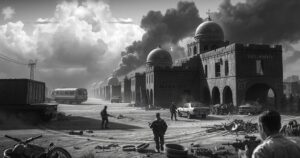South Africa’s Gang Warfare: The Victims Caught in the Crossfire in Cape Town

In Cape Town’s gang-torn areas, families suffer greatly, like Devon Africa, who lost his son and daughter to violence. Despite police interventions and community efforts, gang culture thrives due to socio-economic neglect. Pastor Craven Engel leads initiatives for peace and rehabilitation, aiming to provide pathways out of the cycle of violence. The local and national responses remain inadequate in curbing this ongoing crisis.
In Cape Town, gang violence has become a grim reality for many, as families are tragically shattered by the conflict. Just recently, Devon Africa lost his four-year-old son, Davin, who was caught in a gang shoot-out. This heartbreaking incident exemplifies the horrors faced by residents in areas like Wesbank, which are plagued by persistent gang warfare, a remnant of apartheid’s legacy that forced people into under-resourced outlying townships.
Devon’s family is not alone in this suffering; just two years prior, they lost Davin’s older sister, 12-year-old Kelly Amber, also to violence between rival gangs. With only their youngest daughter left, Undean, Davin’s mother, painfully reassures her, telling her that her brother is in her heart and with Jesus. Despite police assurances of increased efforts, the gang-related murders continue to surge in the Western Cape, a troubling reality that finds roots deep in the fabric of these communities.
The statistics paint an alarming picture: the Western Cape consistently accounts for the vast majority of gang-related homicides in South Africa. Even with the national government’s declared commitments to combat this issue — including the establishment of a special anti-gang unit by President Cyril Ramaphosa and a brief military presence — the killings persist. Gareth Newham from the Institute for Security Studies draws attention to the historical and socio-economic factors that fuel this violence.
Newham asserts that generations of residents, often neglected by the state, find themselves drawn into gang culture as these groups fill the void left by inadequate governmental support. Offering some financial assistance and community structure, gangs engage in activities like providing food and helping with schooling. Unfortunately, their integration into the community makes efforts to dismantle them more complicated.
Efforts to bridge the divide, however, are underway. Pastor Craven Engel from Hanover Park tirelessly mediates conflicts to help reduce violence driven by powerful drug trade networks. He believes that without economic opportunities, many in the community resort to the drug culture as a means of survival. Engel, who manages a peace initiative, emphasizes the lasting effects of apartheid and generational trauma on local residents, many of whom grapple with addiction and its repercussions.
Daily life for the residents of Hanover Park oscillates between survival and despair, with shootings occurring almost routinely. Younger individuals are increasingly involved in these gangs and the resulting violence. Engel cautions that an aggressive policing strategy will not eradicate the issue; even if arrests are made, fresh recruits fill the gap left by incarcerated gang members, perpetuating a cycle of violence.
Engel remains in constant contact with community leaders and even gang figures to broker ceasefires and dissuade violent conflict. During a recent conversation with a jailed gang boss, he encountered an unyielding disposition toward vengeance, highlighting the extent of the grip gangs have on the youth. The precarious peace established through these negotiations is often fleeting, immediately disrupted by acts of violence.
Yet, amid this chaos, there are glimmers of hope. Individuals like Fernando “Nando” Johnston, who is seeking to break free from the clutches of gang life, represent the possibility for transformation with Engel’s guidance. Nando expresses a desire for change, aware that life in the gang lifestyle typically leads to a grim fate. Engel offers him a chance for rehabilitation funded by donations, a choice many see as an opportunity for a fresh start.
Despite the dire circumstances, hope persists, though it is fragile. Pastor Engel notes, “Nando is stabilising,” indicating progress in Johnston’s treatment program, which aims to help residents find employment instead of succumbing to the drug trade. Families strive to support those seeking change, but the weight of generational trauma looms heavily.
As illustrated by the overwhelming challenges faced by families like Devon and Undean, hope may flicker on occasion, but it often feels scarce in the face of continuous violence. Newham reinforces the community’s skepticism toward police intervention, with many fearing corruption and inaction.
Ultimately, with little expectation for external aid to resolve their struggles, Pastor Engel stresses the need for self-reliance, resilience, and a concerted effort to uplift their community. The undying flame of determination remains as residents engulfed in this war for survival continue to seek pathways out of despair, although the road ahead remains daunting.
The ongoing gang violence in Cape Town tragically impacts families and communities. Despite some efforts to combat the issue, such as mediation by figures like Pastor Craven Engel, the deep-rooted socio-economic challenges and historical legacies complicate the situation. Individuals like Nando Johnston show that hope still exists, as communities strive for peace and recovery amidst relentless struggles. Without more comprehensive support, however, the cycle of violence may continue unchecked, demanding urgent attention from all levels of society.
Original Source: www.bbc.com







